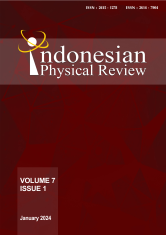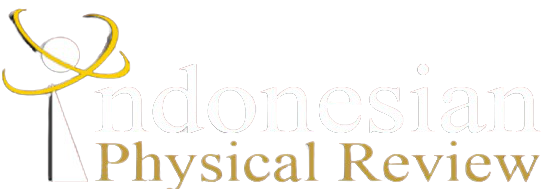ROTATION COMPONENT OF ROBOTIC MANIPULATOR MOTION IN 4-DOF BY THE QUATERNION METHOD
DOI:
10.29303/ipr.v7i1.276Downloads
Abstract
Most of the study of robots is about the system. Because of that, we analyze the motion of the robot by using rigid body motion concepts. This study aims to analyze the rotation components of a robotic manipulator with four degrees of freedom (4-DoF) by using the quaternion method of manual analysis so that the end effector of the robotic manipulator under study is obtained. The research is theoretical and was conducted through a review and analysis of related literature. Based on the literature review, the robotic manipulator is a robot with a shape resembling an arm. The robotic manipulator consists of bases, links, joins, and an end effector. In terms of physics, the kinematics of robot motion can be studied based on the concept of rigid body motion. The research shows that the quaternion method can be used to determine the end effector of the rotation component of the robotic manipulator, and the steps are shorter than analyses by using screw and twist theory. Based on this case, the end effector of the rotation component depends on the initial state and the total rotation angle of each join.
Keywords:
Robotic manipulator degree of freedom quaternionReferences
M. Irsan Kasau and S. Aminah Dinayati Ghani, “ANALISIS KINEMATIK ROBOT KOORDINAT BOLA, ENAM DERAJAT KEBEBASAN DENGAN METODE QUATERNION & ROTATION VECTOR,†2018.
V. G. Pratheep, M. Chinnathambi, E. B. Priyanka, P. Ponmurugan, and P. Thiagarajan, “Design and Analysis of six DOF Robotic Manipulator,†IOP Conf. Ser. Mater. Sci. Eng., vol. 1055, no. 1, p. 012005, Feb. 2021, doi: 10.1088/1757-899x/1055/1/012005.
D. Suddin and B. Nasrullah, “Rancang Bangun Robot Manipulator Yang Bergerak Secara Translasi Dan Rotasi,†vol. 1, pp. 151–156, 2017, [Online]. Available: http://snp2m.poliupg.ac.id/2017/
M. Faiq, W. Satriatama, and L. Halim, “Perancangan Awal dan Simulasi Lengan Robot 3 Derajat Kebebasan Berbasis Arduino yang Dikontrol dengan Aplikasi,†J. Mech. Eng. Mechatronics, vol. 7, no. 2, pp. 118–130, 2022.
R. M. Murray, Z. Li, and S. S. Sastry, A Mathematical Introduction to Robotic Manipulation, vol. 84, no. 788. 1994.
J. Andika and K. S. Salamah, “Analisis kinematik pada robot hexapod,†J. Teknol. Elektro, vol. 9, no. 2, pp. 83–91, 2018.
J. Gallardo-Alvarado, R. Rodriguez-Castro, L. Perez-Gonzalez, and C. R. Aguilar-Najera, “Kinematics of the 3(RPSP)-S fully spherical parallel manipulator by means of screw theory,†Robotics, vol. 7, no. 2, 2018, doi: 10.3390/robotics7020029.
D. Ge, “Kinematics modeling of redundant manipulator based on screw theory and Newton-Raphson method,†J. Phys. Conf. Ser., vol. 2246, no. 1, p. 012068, Apr. 2022, doi: 10.1088/1742-6596/2246/1/012068.
S. Kucuk and Z. Bingul, “Robot Kinematics: Forward and Inverse Kinematics,†in Industrial Robotics: Theory, Modelling and Control, Pro Literatur Verlag, Germany / ARS, Austria, 2006. doi: 10.5772/5015.
A. E. Salman and M. Roman, “Robot Kinematics,†2022. [Online]. Available: https://www.researchgate.net/publication/365193182
M. Gouasmi, M. Ouali, B. Fernini, and M. Meghatria, “Kinematic modelling and simulation of a 2-R robot using solidworks and verification by matlab/simulink,†Int. J. Adv. Robot. Syst., vol. 9, Dec. 2012, doi: 10.5772/50203.
L. P. B. Yasmini and I. G. A. Gunadi, “KAJIAN AWAL PENERAPAN KONSEP MEKANIKA PADA GERAK ROBOT DENGAN ANALISIS ALJABAR,†2012.
J. B. Kuipers, “Quaternions and rotation sequences _ a primer with applications to orbits, aerospace, and virtual reality,†1999.
V. Artale, C. L. R. Milazzo, and A. Ricciardello, “An example of quaternion parameterization for dynamical simulations,†J. Phys. Conf. Ser., vol. 490, no. 1, pp. 6–10, 2014, doi: 10.1088/1742-6596/490/1/012005.
R. Anderson and G. C. Joshi, “Quaternions and the Heuristic Role of Mathematical Structures in Physics,†Phys. Essays, vol. 6, no. 2, pp. 308–319, 1993, doi: 10.4006/1.3029063.
C. F. F. Karney, “Quaternions in molecular modeling,†J. Mol. Graph. Model., vol. 25, no. 5, pp. 595–604, 2007, doi: 10.1016/j.jmgm.2006.04.002.
R. M. Murray, Z. Li, and S. S. Sastry, A Mathematical Introduction to Robotic Manipulation Richard, vol. 84, no. 788. 1994.
License

This work is licensed under a Creative Commons Attribution-NonCommercial-ShareAlike 4.0 International License.
Authors who publish with Indonesian Physical Review Journal, agree to the following terms:
- Authors retain copyright and grant the journal right of first publication with the work simultaneously licensed under a Creative Commons Attribution-ShareAlike 4.0 International Licence (CC BY SA-4.0). This license allows authors to use all articles, data sets, graphics, and appendices in data mining applications, search engines, web sites, blogs, and other platforms by providing an appropriate reference. The journal allows the author(s) to hold the copyright without restrictions and will retain publishing rights without restrictions.
- Authors are able to enter into separate, additional contractual arrangements for the non-exclusive distribution of the journal's published version of the work (e.g., post it to an institutional repository or publish it in a book), with an acknowledgment of its initial publication in Indonesian Physical Review Journal.
- Authors are permitted and encouraged to post their work online (e.g., in institutional repositories or on their website) prior to and during the submission process, as it can lead to productive exchanges, as well as earlier and greater citation of published work (See The Effect of Open Access).





